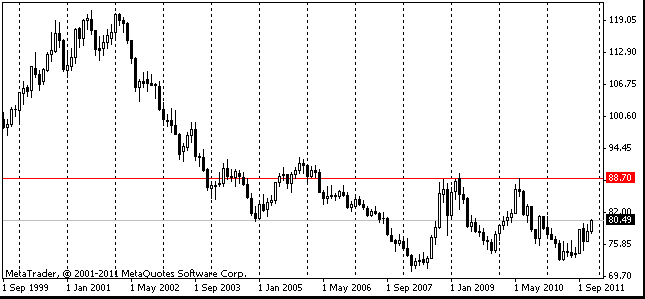EUR/usd
The single currency fell below 1.30 yesterday and didn't manage to recover in the course of the day. Some treat such a sudden sale of the euro as a consequence of investors' disappointment in Merkel's decision not to expand the size of the EFSF. Others also see the reason in the fact that agreements which were negotiated and signed by the heads of European states during the EU summit are still to be approved by the governments. And this issue is not that simple. But there is one more factor – the fall of liquidity at the end of the year. Market participants point out a serious decline in trade volumes, exceeding even their traditional seasonal reduction. The euro simply has no buyers. All the money is poured into liquidity. Yesterday we mentioned the slump in the price of gold. A serious capital outflow from Asia can be also added to this. Capitals are turned into liquidity to form the portfolio for the coming quarter or year. Fund managers have something to dwell on. In the foreseeable future the center of growth will remain in Asia, but the dynamics has radically changed. Asia was stepping on the brakes in summer, but now it seems as if China feared a hard landing. Europe is forecasted to stagnate next year. Hardly anyone doubts that already now the region has stepped into recession, and, moreover, Reuters's survey of economists showed that this situation may last over the first half of the coming year. By contrast the U.S. demonstrates a conspicuous improvement in the labor market and in production. If the prices for raw materials remain low which will be possible in case of the weak growth in the rest of the world, the next year may become the year of the dollar. The dollar index increased from 73.50 to 80.50 in July and the technical perspective suggests that it still has the potential to go up by about 10%. However, the euro may try to bounce up later this week. The local minimum of January 2011 was 1.2875. Having easily breached it this week without any news, the pair may get a short-term support from bargain hunters as the move down was so fast.

GBP/USD
sterling has considerably advanced against the euro this week. That contrast was especially clear during yesterday's trading in Europe. By the way, pound buyers had a formal reason to act. Yesterday's labor market report turned out to be not as pessimistic as expected. The claimant count increase made only 3K against the expected 16K. The unemployment rate remained unchanged at 8.3%, though it had been forecasted to rise to 8.4%. Thursday abounds in statistical data, and as far as Britain is concerned the market is expecting the release of this country's retail sales report. In fact, the market is anticipating disappointing news, as according to the average forecast sales are expected to go down by 0.3% m / m, after the 0.6% rise in the previous month. If weak news comes out and the euro remains unfavoured, the pound can be easily deprived of its immunity. Please note that the pound is now trading a bit more than one big figure above a strong support line, passing through 1.5340. It gives us an idea that the pound may occur in the same situation as the euro after breaching its support level, namely, it may suffer a continuous decline. Apart from retail sales the BOE's survey on the expected inflation rate is of interest. In the third quarter of this year people estimated the growth rate at 4.2%, while it actually exceeded 5%. Will consumers bet on a sharper slowdown now? If they did it would give the BoE a free hand in implementing their QE programme.

USD/JPY
The dollar/yen rose to 78.0 yesterday, but still it's not strong enough to climb higher. The decline of stock markets does not help. The old traders' reflex – to sell the pair on fall of shares – is deeply rooted in their consciousness, despite the fact that the basic principles of this strategy already don't work (we've described it earlier). Thus, along with the strengthening of the dollar index, we can also observe the growth of usdjpy. In fact, it is the only major currency, which has showed a more or less conspicuous shift to the dollar this year (weakening of the dollar from 83 yen to 78 now). But this trend may be heading for its end.

AUD/USD
Bulls have left the aussie. It has been falling since the beginning of this week, having dipped from 1.02 to the current level of 0.99. But the failure to breach the 1.0150-1.0300 corridor became a turning point. It seems as though the pair was set to close the gap which formed two weeks ago. If so, this is the course to 0.97. It's about time as the expectations that the ECB will support eurozone debt markets haven't been surpassed! All attention is now focused on what steps the European politicians will further take. In the long run the prospects for the Australian dollar can prove to be not very rosy due to a sharp slowdown in Asia.
